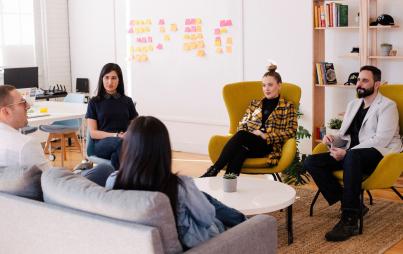
The fact is I don’t have time. I’m overwhelmed, and I’m way behind on my work.
This article first appeared on SHE'SAID' and has been republished with permission.
My desk is littered in chewing gum wrappers and coffee cup rings; a sad pink Kmart desk fan rhythmically flicking crumpled Post-Its up and down as I type.
My work area appears to be the embodiment of a teenage girl’s chaotic bedroom — sun-faded motivational stickers and juvenile bric-a-brac consume most of its real estate. Long-forgotten to-do lists and unopened packets of preppy stationery are a depressing reminder I’ve all but given up hope I’ll put my organizational Pinterest board to use one day.
The fact is I don’t have time. I’m overwhelmed, and I’m way behind on my work. The sleeping tablet I took last night to shut off my stressed-out brain is slowing my thinking and making me so tired I feel as though I could spontaneously drop my head into the keyboard and sleep, unperturbed, for hours. It’s almost noon, and besides answering my emails and finishing off the last of my jar of ‘de-stressing’ multivitamins while scrolling my morning news feed on my third cup of coffee, I’ve achieved a fairly unremarkable amount.
In the modern, open-plan work space of aggressively driven forward-thinkers and self-starters, where there’s nowhere to hide, and no room for excuses, I can’t help but feel like a bit of a failure.
Even my painfully 80s ‘Hang in there!’ poster can’t save me now. (Although, admittedly, you’d have to be without a soul not to find the image of a kitten comically dangling from a tree branch satisfying.)
Office motivational posters aside, over half of American employees feel overworked or overwhelmed at least some of the time, and, as a result they’re drifting into similar zombie-like states. A 2014 survey conducted by Salary.com, found a whopping 89 percent of employees waste considerable time at work; a figure which rose by 20 percent from the previous year. It makes sense then, we’re not only rapidly losing productivity, but have developed an entire vernacular to express our distaste for the modern workweek.
Phrases like “I hate Mondays” and “TGIF” have become so ingrained in our work culture, we proudly sport them on our coffee mugs as we wearily throw back another hit of Starbucks to keep our eyes open through the next pointless meeting. And characters like Peter Gibbons from 1999’s iconic Office Space who is perhaps best known for his line, “I’d say, in a given week, I probably do about 15 minutes of real, actual work” remain hilariously, if not uncomfortably, relatable.
It begs the question; if the 40-hour workweek isn’t working for us, why are we persisting in working it?
Keeping the status quo

Despite our insistence of workplace progression through gestures like office game rooms, communal snacks and cubicle-free work spaces, there’s little to suggest businesses have taken a single stride forward since 1914, when the Ford Motor Company scaled to a five-day, eight-hours-a-day workweek, after founder Henry Ford discovered excessive work hours were negatively affecting productivity, which was ultimately formalized by Congress in the 1938 Fair Labor Standards Act.
Eight odd decades later, and the 40-hour nine-to-five workweek — which has gradually evolved to the more brutal eight-to-six workweek — has remained largely unchallenged, despite its obscurity in the new technological landscape, which has made options like flexible hours and working remotely more achievable, and practical, than ever before.
In fact, in over half of all families with young children today, both parents now work. The option of being a stay-at-home mom while your significant other goes out to “earn the bacon” is becoming increasingly obsolete, thanks to rising living costs and shifting gender roles. Add to that the fact that two thirds of adults own smartphones, and over 70 percent of us have a desktop computer or laptop at home, and there’s more of a compelling case than ever for supporting a work culture that isn’t so intrinsically bound within an office, during set hours.
You Might Also Like: Working Full-Time With Mental Illness Is Hard: Here's How I Do It
Take, for example, my job. I’m a writer and editor who runs a website with a team of staff who work from around the world. Due to the 24/7 nature of online media, and working globally, more often than not, I’m tapping away at my laptop in bed before I turn in for the night, and there are few weekends or holidays in which I haven’t had to log on and check everything was running as it should, or make a late-night video call to a writer across timezones. I also work best in the evening, and have been known to get on a roll at midnight that takes me through to three or four in the morning, and on top of my work schedule, I’m managing health issues. Sitting at a desk attempting to write or edit a thought-provoking article in a noisy office during my worst hours for productivity makes no sense – for my success as an employee, or my health – and yet, it’s always been an expectation of my job, regardless of where I’ve worked over the years.
A recent study by Oxford Economics confirms this counter intuitiveness. In the study, respondents ranked “the ability to focus and work without interruptions” as being most important factor in their work environment; far outweighing perks like free food and casual Friday dress codes, and even above having a staff break room. However, while more than half the staff surveyed indicated they weren’t equipped to successfully overcome workplace distractions, two thirds of managers reported they believed their employees were.
Office space

While most companies prescribe to the theory that cramming all their employees into offices — whether open plan or the cubicle format immortalized in Office Space — ultimately cuts costs and allows for better management of productivity levels, ironically the inverse is true; modern businesses are paying the ultimate price in lost time as a direct result of workplace distractions and low morale — generally at its worst around the hours of three to four p.m.
Just Google ‘Beat the 3pm slump’ and you’ll be met with over 273,000 articles providing advice on how to overcome the very real phenomenon we’ve all witnessed in the afternoon at work; coworkers dropping like flies — logging onto Facebook, heading to the vending machine for a pick-me-up, or loitering in the office break room for a reprieve from their monitors. It seems around that time of day, almost no one is doing any meaningful work; even those still dutifully seated at their desks look weary-eyed as they absentmindedly scroll back and forth over the same screen of flow charts. And it’s incredibly costly for workplaces. Business liability insurance company BOLT released figures estimating wasted time on “non-work tasks” cost American employers around $134 billion in 2012 alone.
But there are a few companies that are taking note, and reaping the rewards. A couple of years ago, online retail giant Amazon announced it was trialling a 30-hour workweek, in which employees were invited to work from 10a.m. to 2p.m., Monday to Thursday, with the remaining hours distributed whenever was most convenient for each individual. In Sweden, online search optimization company Brath is perhaps best known for operating on a six-hour workday, offering full pay and benefits, in return for which, the business boasts it enjoys high retention and staff productivity.
“Today we get more done in six hours than comparable companies do in eight,” the company’s founder, Magnus Brath, said of the bold business decision, in a post on the company’s website.
“We believe it comes with the high level of creativity demanded in this line of work. We believe nobody can be creative and productive in eight hours straight. Six hours is more reasonable, even though we too, of course, check Facebook or the news at times.”
As I’m finishing up this article, after futilely attempting to drown out my own office distractions with headphones and successive snack breaks to get my mental cognition back into gear in between fending off interruptions and chipping away at today’s to-do list, it occurs to me I have a report to file and half a dozen more articles left to edit.
My flimsy desk fan is still flapping Post-It notes around my desk, scrawled with additional reminders of tasks I have yet to check off, and in the time it’s taken me to create tomorrow’s new inevitably insurmountable to-do list, my inbox has once again filled back up. On the upside, my sleeping pill haze has predictably worn off, so now I’m more focused and energized than I’ve been all day. And most people have packed up around me, so the office has finally quietened down, allowing me to get into my zone; there’s just one problem.
It’s 7 p.m. And in the immortal words of Peter Gibbons, I’ve gotta get out of here. Or else, I’m going to lose it.
GIFs via giphy.com.
More From SHE'SAID':
-
It’s Still Harder To Be A Woman In The Workplace Today
-
27 Ways To Make Your Commute To Work Less Of A Living Hell
-
I’m A 34 Year-Old Woman Who Doesn’t Want a Promotion








